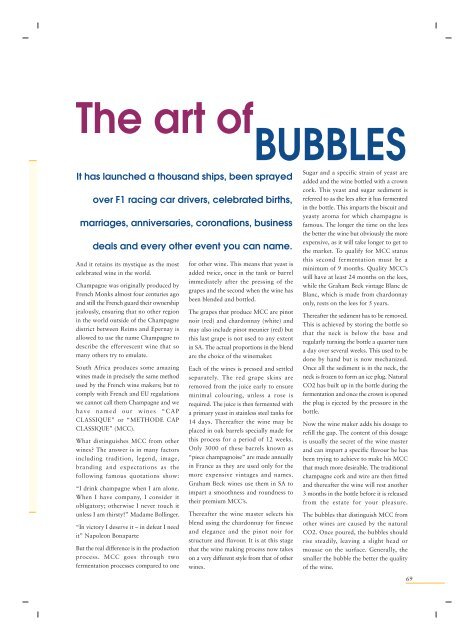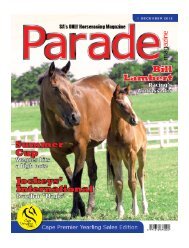sa horseracing convention road to the future glory - PARADE ...
sa horseracing convention road to the future glory - PARADE ...
sa horseracing convention road to the future glory - PARADE ...
You also want an ePaper? Increase the reach of your titles
YUMPU automatically turns print PDFs into web optimized ePapers that Google loves.
The art of<br />
BUBBLES<br />
It has launched a thou<strong>sa</strong>nd ships, been sprayed<br />
over F1 racing car drivers, celebrated births,<br />
marriages, anniver<strong>sa</strong>ries, coronations, business<br />
deals and every o<strong>the</strong>r event you can name.<br />
And it retains its mystique as <strong>the</strong> most<br />
celebrated wine in <strong>the</strong> world.<br />
Champagne was originally produced by<br />
French Monks almost four centuries ago<br />
and still <strong>the</strong> French guard <strong>the</strong>ir ownership<br />
jealously, ensuring that no o<strong>the</strong>r region<br />
in <strong>the</strong> world outside of <strong>the</strong> Champagne<br />
district between Reims and Epernay is<br />
allowed <strong>to</strong> use <strong>the</strong> name Champagne <strong>to</strong><br />
describe <strong>the</strong> effervescent wine that so<br />
many o<strong>the</strong>rs try <strong>to</strong> emulate.<br />
South Africa produces some amazing<br />
wines made in precisely <strong>the</strong> <strong>sa</strong>me method<br />
used by <strong>the</strong> French wine makers; but <strong>to</strong><br />
comply with French and EU regulations<br />
we cannot call <strong>the</strong>m Champagne and we<br />
have named our wines “CAP<br />
CLASSIQUE” or “METHODE CAP<br />
CLASSIQUE” (MCC).<br />
What distinguishes MCC from o<strong>the</strong>r<br />
wines? The answer is in many fac<strong>to</strong>rs<br />
including tradition, legend, image,<br />
branding and expectations as <strong>the</strong><br />
following famous quotations show:<br />
“I drink champagne when I am alone.<br />
When I have company, I consider it<br />
obliga<strong>to</strong>ry; o<strong>the</strong>rwise I never <strong>to</strong>uch it<br />
unless I am thirsty!” Madame Bollinger.<br />
“In vic<strong>to</strong>ry I deserve it – in defeat I need<br />
it” Napoleon Bonaparte<br />
But <strong>the</strong> real difference is in <strong>the</strong> production<br />
process. MCC goes through two<br />
fermentation processes compared <strong>to</strong> one<br />
for o<strong>the</strong>r wine. This means that yeast is<br />
added twice, once in <strong>the</strong> tank or barrel<br />
immediately after <strong>the</strong> pressing of <strong>the</strong><br />
grapes and <strong>the</strong> second when <strong>the</strong> wine has<br />
been blended and bottled.<br />
The grapes that produce MCC are pinot<br />
noir (red) and chardonnay (white) and<br />
may also include pinot meunier (red) but<br />
this last grape is not used <strong>to</strong> any extent<br />
in SA. The actual proportions in <strong>the</strong> blend<br />
are <strong>the</strong> choice of <strong>the</strong> winemaker.<br />
Each of <strong>the</strong> wines is pressed and settled<br />
separately. The red grape skins are<br />
removed from <strong>the</strong> juice early <strong>to</strong> ensure<br />
minimal colouring, unless a rose is<br />
required. The juice is <strong>the</strong>n fermented with<br />
a primary yeast in stainless steel tanks for<br />
14 days. Thereafter <strong>the</strong> wine may be<br />
placed in oak barrels specially made for<br />
this process for a period of 12 weeks.<br />
Only 3000 of <strong>the</strong>se barrels known as<br />
“piece champagnoise” are made annually<br />
in France as <strong>the</strong>y are used only for <strong>the</strong><br />
more expensive vintages and names.<br />
Graham Beck wines use <strong>the</strong>m in SA <strong>to</strong><br />
impart a smoothness and roundness <strong>to</strong><br />
<strong>the</strong>ir premium MCC’s.<br />
Thereafter <strong>the</strong> wine master selects his<br />
blend using <strong>the</strong> chardonnay for finesse<br />
and elegance and <strong>the</strong> pinot noir for<br />
structure and flavour. It is at this stage<br />
that <strong>the</strong> wine making process now takes<br />
on a very different style from that of o<strong>the</strong>r<br />
wines.<br />
Sugar and a specific strain of yeast are<br />
added and <strong>the</strong> wine bottled with a crown<br />
cork. This yeast and sugar sediment is<br />
referred <strong>to</strong> as <strong>the</strong> lees after it has fermented<br />
in <strong>the</strong> bottle. This imparts <strong>the</strong> biscuit and<br />
yeasty aroma for which champagne is<br />
famous. The longer <strong>the</strong> time on <strong>the</strong> lees<br />
<strong>the</strong> better <strong>the</strong> wine but obviously <strong>the</strong> more<br />
expensive, as it will take longer <strong>to</strong> get <strong>to</strong><br />
<strong>the</strong> market. To qualify for MCC status<br />
this second fermentation must be a<br />
minimum of 9 months. Quality MCC’s<br />
will have at least 24 months on <strong>the</strong> lees,<br />
while <strong>the</strong> Graham Beck vintage Blanc de<br />
Blanc, which is made from chardonnay<br />
only, rests on <strong>the</strong> lees for 5 years.<br />
Thereafter <strong>the</strong> sediment has <strong>to</strong> be removed.<br />
This is achieved by s<strong>to</strong>ring <strong>the</strong> bottle so<br />
that <strong>the</strong> neck is below <strong>the</strong> base and<br />
regularly turning <strong>the</strong> bottle a quarter turn<br />
a day over several weeks. This used <strong>to</strong> be<br />
done by hand but is now mechanized.<br />
Once all <strong>the</strong> sediment is in <strong>the</strong> neck, <strong>the</strong><br />
neck is frozen <strong>to</strong> form an ice plug. Natural<br />
CO2 has built up in <strong>the</strong> bottle during <strong>the</strong><br />
fermentation and once <strong>the</strong> crown is opened<br />
<strong>the</strong> plug is ejected by <strong>the</strong> pressure in <strong>the</strong><br />
bottle.<br />
Now <strong>the</strong> wine maker adds his do<strong>sa</strong>ge <strong>to</strong><br />
refill <strong>the</strong> gap. The content of this do<strong>sa</strong>ge<br />
is usually <strong>the</strong> secret of <strong>the</strong> wine master<br />
and can impart a specific flavour he has<br />
been trying <strong>to</strong> achieve <strong>to</strong> make his MCC<br />
that much more desirable. The traditional<br />
champagne cork and wire are <strong>the</strong>n fitted<br />
and <strong>the</strong>reafter <strong>the</strong> wine will rest ano<strong>the</strong>r<br />
3 months in <strong>the</strong> bottle before it is released<br />
from <strong>the</strong> estate for your pleasure.<br />
The bubbles that distinguish MCC from<br />
o<strong>the</strong>r wines are caused by <strong>the</strong> natural<br />
CO2. Once poured, <strong>the</strong> bubbles should<br />
rise steadily, leaving a slight head or<br />
mousse on <strong>the</strong> surface. Generally, <strong>the</strong><br />
smaller <strong>the</strong> bubble <strong>the</strong> better <strong>the</strong> quality<br />
of <strong>the</strong> wine.<br />
69






